Wetland Changes and Their Relation to Climate Change in the Pumqu Basin, Tibetan Plateau
Abstract
1. Introduction
2. Materials and Methods
2.1. Study Area
2.2. Data Source
2.2.1. Remote Sensing Data
2.2.2. Topographic and Meteorological Data
2.3. Methods
2.3.1. Alpine Wetland Classification and Extraction
2.3.2. Grey Correlation Analysis
3. Results
3.1. Wetland Distribution and Change Characteristics
3.1.1. Wetland Composition and Changes
3.1.2. Horizontal Distribution Characteristics of Wetlands
3.1.3. Vertical Distribution Characteristics of Wetlands
3.1.4. Spatial Characteristics of Wetland Changes
3.2. Relationship between Wetland Changes and Climate Change
3.2.1. Wetland Area and Temperature
3.2.2. Wetland Area and Precipitation
3.2.3. Wetlands and Climatic Factors
4. Discussion
4.1. Wetland Changes
4.2. Climatic Factors Impact Wetlands
4.3. Policy Implications
4.4. Study Limitations
5. Conclusions
Author Contributions
Funding
Informed Consent Statement
Data Availability Statement
Acknowledgments
Conflicts of Interest
References
- Brinson, M.M.; Malvarez, A.I. Temperate freshwater wetlands: Types, status, and threats. Environ. Conserv. 2002, 29, 115–133. [Google Scholar] [CrossRef]
- Guo, M.; Li, J.; Sheng, C.; Xu, J.; Wu, L. A Review of Wetland Remote Sensing. Sensors 2017, 17, 777. [Google Scholar] [CrossRef] [PubMed]
- Mahdavi, S.; Salehi, B.; Granger, J.; Amani, M.; Brisco, B.; Huang, W. Remote sensing for wetland classification: A comprehensive review. GISci. Remote Sens. 2018, 55, 623–658. [Google Scholar] [CrossRef]
- Asselen, S.V.; Verburg, P.H.; Vermaat, J.E.; Janse, J.H. Drivers of Wetland Conversion: A Global Meta-Analysis. PLoS ONE 2013, 8, e81292. [Google Scholar] [CrossRef] [PubMed]
- Davidson, N.C. How much wetland has the world lost? Long-term and recent trends in global wetland area. Mar. Freshw. Res. 2014, 65, 934. [Google Scholar] [CrossRef]
- Junk, W.J.; An, S.; Finlayson, C.M.; Gopal, B.; Květ, J.; Mitchell, S.A.; Mitsch, W.J.; Robarts, R.D. Current state of knowledge regarding the world’s wetlands and their future under global climate change: A synthesis. Aquat. Sci. 2013, 75, 151–167. [Google Scholar] [CrossRef]
- Reis, V.; Hermoso, V.; Hamilton, S.K.; Ward, D.; Fluet-Chouinard, E.; Lehner, B.; Linke, S. A Global Assessment of Inland Wetland Conservation Status. Bioscience 2017, 67, 523–533. [Google Scholar] [CrossRef]
- Hu, S.; Niu, Z.; Chen, Y.; Li, L.; Zhang, H. Global wetlands: Potential distribution, wetland loss, and status. Sci. Total Environ. 2017, 586, 319–327. [Google Scholar] [CrossRef] [PubMed]
- Ribeiro De Almeida, T.I.; Penatti, N.C.; Ferreira, L.G.; Arantes, A.E.; Do Amaral, C.H. Principal component analysis applied to a time series of MODIS images: The spatio-temporal variability of the Pantanal wetland, Brazil. Wetl. Ecol. Manag. 2015, 23, 737–748. [Google Scholar] [CrossRef]
- Libonati, R.; DaCamara, C.C.; Peres, L.F.; Sander De Carvalho, L.A.; Garcia, L.C. Rescue Brazil’s burning Pantanal wetlands. Nature 2020, 588, 217–219. [Google Scholar] [CrossRef]
- Guerra, A.; Roque, F.D.O.; Garcia, L.C.; Ochoa-Quintero, J.M.; Oliveira, P.T.S.D.; Guariento, R.D.; Rosa, I.M.D. Drivers and projections of vegetation loss in the Pantanal and surrounding ecosystems. Land Use Policy 2020, 91, 104388. [Google Scholar] [CrossRef]
- Li, X.; Song, K.; Liu, G. Wetland Fire Scar Monitoring and Its Response to Changes of the Pantanal Wetland. Sensors 2020, 20, 4268. [Google Scholar] [CrossRef]
- Mitsch, W.J.; Hernandez, M.E. Landscape and climate change threats to wetlands of North and Central America. Aquat. Sci. 2013, 75, 133–149. [Google Scholar] [CrossRef]
- Mao, D.; Wang, Z.; Du, B.; Li, L.; Tian, Y.; Jia, M.; Zeng, Y.; Song, K.; Jiang, M.; Wang, Y. National wetland mapping in China: A new product resulting from object-based and hierarchical classification of Landsat 8 OLI images. ISPRS J. Photogramm. Remote Sens. 2020, 164, 11–25. [Google Scholar] [CrossRef]
- Mao, D.; Luo, L.; Wang, Z.; Wilson, M.C.; Zeng, Y.; Wu, B.; Wu, J. Conversions between natural wetlands and farmland in China: A multiscale geospatial analysis. Sci. Total Environ. 2018, 634, 550–560. [Google Scholar] [CrossRef]
- Yu, X.; Ding, S.; Zou, Y.; Xue, Z.; Lyu, X.; Wang, G. Review of Rapid Transformation of Floodplain Wetlands in Northeast China: Roles of Human Development and Global Environmental Change. Chin. Geogr. Sci. 2018, 28, 654–664. [Google Scholar] [CrossRef]
- Mao, D.; Tian, Y.; Wang, Z.; Jia, M.; Du, J.; Song, C. Wetland changes in the Amur River Basin: Differing trends and proximate causes on the Chinese and Russian sides. J. Environ. Manag. 2021, 280, 111670. [Google Scholar] [CrossRef] [PubMed]
- Ma, C.; He, Y. Spatiotemporal Trends and Ecological Determinants in Population by Elevation in China Since 1990. Chin. Geogr. Sci. 2021, 31, 248–260. [Google Scholar] [CrossRef]
- Kuang, X.; Jiao, J.J. Review on climate change on the Tibetan Plateau during the last half century. J. Geophys. Res. Atmos. 2016, 121, 3979–4007. [Google Scholar] [CrossRef]
- Wang, R.; He, M.; Niu, Z. Responses of Alpine Wetlands to Climate Changes on the Qinghai-Tibetan Plateau Based on Remote Sensing. Chin. Geogr. Sci. 2020, 30, 189–201. [Google Scholar] [CrossRef]
- Li, X.; Xue, Z.; Gao, J. Dynamic Changes of Plateau Wetlands in Madou County, the Yellow River Source Zone of China: 1990–2013. Wetlands 2016, 36, 299–310. [Google Scholar] [CrossRef]
- Zhao, Z.; Liu, L.; Wang, Z.; Zhang, Y.; Li, L.; Liu, F. Dynamic Changes of Plateau Wetlands in the Damqu River Basin, Yangtze River Source Region, China, 1988–2015. Wetlands 2020, 40, 1409–1424. [Google Scholar] [CrossRef]
- Jiang, W.; Lv, J.; Wang, C.; Chen, Z.; Liu, Y. Marsh wetland degradation risk assessment and change analysis: A case study in the Zoige Plateau, China. Ecol. Indic. 2017, 82, 316–326. [Google Scholar] [CrossRef]
- Qiu, P.; Wu, N.; Luo, P.; Wang, Z.; Li, M. Analysis of dynamics and driving factors of wetland landscape in Zoige, Eastern Qinghai-Tibetan Plateau. J Mt. Sci. 2009, 6, 42–55. [Google Scholar] [CrossRef]
- Dong, Z.; Hu, G.; Yan, C.; Wang, W.; Lu, J. Aeolian desertification and its causes in the Zoige Plateau of China’s Qinghai–Tibetan Plateau. Environ. Earth Sci. 2010, 59, 1731–1740. [Google Scholar] [CrossRef]
- Li, Z.; Wang, Z.; Brierley, G.; Nicoll, T.; Pan, B.; Li, Y. Shrinkage of the Ruoergai Swamp and changes to landscape connectivity, Qinghai-Tibet Plateau. Catena 2015, 126, 155–163. [Google Scholar] [CrossRef]
- Finlayson, C.M.; Capon, S.J.; Rissik, D.; Pittock, J.; Fisk, G.; Davidson, N.C.; Bodmin, K.A.; Papas, P.; Robertson, H.A.; Schallenberg, M.; et al. Policy considerations for managing wetlands under a changing climate. Mar. Freshw. Res. 2017, 68, 1803–1815. [Google Scholar] [CrossRef]
- Peimer, A.W.; Krzywicka, A.E.; Cohen, D.B.; Van den Bosch, K.; Buxton, V.L.; Stevenson, N.A.; Matthews, J.W. National-Level Wetland Policy Specificity and Goals Vary According to Political and Economic Indicators. Environ. Manag. 2017, 59, 141–153. [Google Scholar] [CrossRef] [PubMed]
- Fickas, K.C.; Cohen, W.B.; Yang, Z. Landsat-based monitoring of annual wetland change in the Willamette Valley of Oregon, USA from 1972 to 2012. Wetl. Ecol. Manag. 2016, 24, 73–92. [Google Scholar] [CrossRef]
- Zhang, W.; Zhang, Y.; Wang, Z.; Ding, M.; Yang, X.; Lin, X.; Liu, L. Vegetation change in the Mt. Qomolangma Nature Reserve from 1981 to 2001. J. Geogr. Sci. 2007, 17, 152–164. [Google Scholar] [CrossRef]
- Salerno, F.; Guyennon, N.; Thakuri, S.; Viviano, G.; Romano, E.; Vuillermoz, E.; Cristofanelli, P.; Stocchi, P.; Agrillo, G.; Ma, Y.; et al. Weak precipitation, warm winters and springs impact glaciers of south slopes of Mt. Everest (central Himalaya) in the last 2 decades (1994–2013). Cryosphere 2015, 9, 1229–1247. [Google Scholar] [CrossRef]
- Han, X.; Guo, Y.; Wen, L.; Mi, C. New Black-necked Crane Grus nigricollis subpopulation recorded in southern Tibet, China. Forktail 2015, 31, 116–118. [Google Scholar]
- Wei, D.; Zhao, H.; Huang, L.; Qi, Y.; Wang, X. Feedbacks of Alpine Wetlands on the Tibetan Plateau to the Atmosphere. Wetlands 2020, 40, 787–797. [Google Scholar] [CrossRef]
- Muro, J.; Canty, M.; Conradsen, K.; Hüttich, C.; Nielsen, A.; Skriver, H.; Remy, F.; Strauch, A.; Thonfeld, F.; Menz, G. Short-Term Change Detection in Wetlands Using Sentinel-1 Time Series. Remote Sens. 2016, 8, 795. [Google Scholar] [CrossRef]
- Tong, L.; Xu, X.; Fu, Y.; Li, S. Wetland Changes and Their Responses to Climate Change in the “Three-River Headwaters” Region of China since the 1990s. Energies 2014, 7, 2515–2534. [Google Scholar] [CrossRef]
- Zhang, J.; Zhang, Y.; Liu, L.; Ding, M.; Zhang, X. Identifying Alpine Wetlands in the Damqu River Basin in the Source Area of the Yangtze River Using Object-based Classification Method. J. Resour. Ecol. 2011, 2, 186–192. [Google Scholar] [CrossRef]
- Zhang, Y.; Wang, C.; Bai, W.; Wang, Z.; Tu, Y.; Yangjaen, D.G. Alpine wetlands in the Lhasa River Basin, China. J. Geogr. Sci. 2010, 20, 375–388. [Google Scholar] [CrossRef]
- Nie, Y.; Li, A. Assessment of Alpine Wetland Dynamics from 1976–2006 in the Vicinity of Mount Everest. Wetlands 2011, 31, 875–884. [Google Scholar] [CrossRef]
- Fang, L.; Dong, B.; Wang, C.; Yang, F.; Cui, Y.; Xu, W.; Peng, L.; Wang, Y.; Li, H. Research on the influence of land use change to habitat of cranes in Shengjin Lake wetland. Environ. Sci. Pollut. Res. 2020, 27, 7515–7525. [Google Scholar] [CrossRef]
- Li, W.; Xue, P.; Liu, C.; Yan, H.; Zhu, G.; Cao, Y. Monitoring and Landscape Dynamic Analysis of Alpine Wetland Area Based on Multiple Algorithms: A Case Study of Zoige Plateau. Sensors 2020, 20, 7315. [Google Scholar] [CrossRef]
- Shen, G.; Yang, X.; Jin, Y.; Xu, B.; Zhou, Q. Remote sensing and evaluation of the wetland ecological degradation process of the Zoige Plateau Wetland in China. Ecol. Indic. 2019, 104, 48–58. [Google Scholar] [CrossRef]
- Wang, X.; Zhang, F.; Kung, H.; Johnson, V.C. New methods for improving the remote sensing estimation of soil or-ganic matter content (SOMC) in the Ebinur Lake Wetland National Nature Reserve (ELWNNR) in northwest China. Remote Sens. Environ. 2018, 218, 104–118. [Google Scholar] [CrossRef]
- Li, F.; Chang, G.; Xiao, J.; Zhou, B.; Fu, Y. Relationship between Wetlands Changes and Climate Change in the Yellow River Source Region. J. Nat. Resour. 2009, 24, 683–690. [Google Scholar] [CrossRef]
- Kundu, P. Geomorphic control on wetland classification: A case study in Himalayan Floodplain region. Spat. Inf. Res. 2020. [Google Scholar] [CrossRef]
- Chembolu, V.; Dubey, A.K.; Gupta, P.K.; Dutta, S.; Singh, R.P. Application of satellite altimetry in understanding river-wetland flow interactions of Kosi river. J. Earth Syst. Sci. 2019, 128, 1–15. [Google Scholar] [CrossRef]
- Larocque, M.; Biron, P.M.; Buffin-Bélanger, T.; Needelman, M.; Cloutier, C.; McKenzie, J.M. Role of the geomorphic setting in controlling groundwater-surface water exchanges in riverine wetlands: A case study from two southern Québec rivers (Canada). Can. Water Resour. J. 2016, 41, 528–542. [Google Scholar] [CrossRef]
- Li, X. Analysis on Landscape Pattern Changes of Typical Alpine Wetland in Kong Ga Town of Ding Ri in Recent 20 Years. Master’s Thesis, Chengdu University of Technology, Chengdu, China, 2013. Available online: http://d.wanfangdata.com.cn/thesis/Y2342493 (accessed on 26 May 2019).
- Liu, Y.; Sheng, L.; Liu, J. Impact of wetland change on local climate in semi-arid zone of Northeast China. Chin. Geogr. Sci. 2015, 25, 309–320. [Google Scholar] [CrossRef]
- Zhang, G.; Yao, T.; Xie, H.; Yang, K.; Zhu, L.; Shum, C.K.; Bolch, T.; Yi, S.; Allen, S.; Jiang, L.; et al. Response of Tibetan Plateau lakes to climate change: Trends, patterns, and mechanisms. Earth Sci. Rev. 2020, 208, 103269. [Google Scholar] [CrossRef]
- Ma, N.; Szilagyi, J.; Niu, G.; Zhang, Y.; Zhang, T.; Wang, B.; Wu, Y. Evaporation variability of Nam Co Lake in the Tibetan Plateau and its role in recent rapid lake expansion. J. Hydrol. 2016, 537, 27–35. [Google Scholar] [CrossRef]
- Biskop, S.; Maussion, F.; Krause, P.; Fink, M. Differences in the water-balance components of four lakes in the south-ern-central Tibetan Plateau. Hydrol. Earth Syst. Sci. 2016, 20, 209–225. [Google Scholar] [CrossRef]
- Xiang, S.; Guo, R.; Wu, N.; Sun, S. Current status and future prospects of Zoige Marsh in Eastern Qinghai-Tibet Plateau. Ecol. Eng. 2009, 35, 553–562. [Google Scholar] [CrossRef]
- Xue, Z.; Lyu, X.; Chen, Z.; Zhang, Z.; Jiang, M.; Zhang, K.; Lyu, Y. Spatial and Temporal Changes of Wetlands on the Qinghai-Tibetan Plateau from the 1970s to 2010s. Chin. Geogr. Sci. 2018, 28, 935–945. [Google Scholar] [CrossRef]
- Du, J.; Wang, G.; Yang, Y.; Zhang, T.; Mao, T. Temporal and spatial variation of the distributive patterns and driving force analysis in the Yangtze River and Yellow River source regions wetland. Acta Ecol. Sin. 2015, 35, 6173–6182. [Google Scholar] [CrossRef][Green Version]
- Hussien, K.; Demissie, B.; Meaza, H. Spatiotemporal wetland changes and their threats in North Central Ethiopian Highlands. Singap. J. Trop. Geogr. 2018, 39, 332–350. [Google Scholar] [CrossRef]
- Li, N.; Li, L.; Lu, D.; Zhang, Y.; Wu, M. Detection of coastal wetland change in China: A case study in Hangzhou Bay. Wetl. Ecol. Manag. 2019, 27, 103–124. [Google Scholar] [CrossRef]
- Xu, X. Data set of population spatial distribution kilometer grid in China. Data registration and publishing system of data center of resources and environment science. Chin. Acad. Sci. 2017. [Google Scholar] [CrossRef]
- Lang, Q.; Niu, Z.; Hong, X.; Yang, X. Remote Sensing Monitoring and Change Analysis of Wetlands in the Tibetan Plateau. Geomat. Inf. Sci. Wuhan Univ. 2021, 46, 230–237. [Google Scholar] [CrossRef]
- Zhang, G.; Luo, W.; Chen, W.; Zheng, G. A robust but variable lake expansion on the Tibetan Plateau. Sci. Bull. 2019, 64, 1306–1309. [Google Scholar] [CrossRef]
- Zhang, G.; Xie, H.; Kang, S.; Yi, D.; Ackley, S.F. Monitoring lake level changes on the Tibetan Plateau using ICESat altimetry data (2003–2009). Remote Sens. Environ. 2011, 115, 1733–1742. [Google Scholar] [CrossRef]
- Sorg, A.; Bolch, T.; Stoffel, M.; Solomina, O.; Beniston, M. Climate change impacts on glaciers and runoff in Tien Shan (Central Asia). Nat. Clim. Chang. 2012, 2, 725–731. [Google Scholar] [CrossRef]
- Yao, T.; Thompson, L.; Yang, W.; Yu, W.; Gao, Y.; Guo, X.; Yang, X.; Duan, K.; Zhao, H.; Xu, B.; et al. Different glacier status with atmospheric circulations in Tibetan Plateau and surroundings. Nat. Clim. Chang. 2012, 2, 663–667. [Google Scholar] [CrossRef]
- Wen, L.; Wang, J.; Zhang, S.; Li, J.; Liu, L. Remote Sensing Monitoring and Dynamics of Wetland in Zhujiangyuan Nature Reserve. J. Southwest For. Univ. 2018, 38, 159–165. [Google Scholar] [CrossRef]
- Nie, Y.; Sheng, Y.; Liu, Q.; Liu, L.; Liu, S.; Zhang, Y.; Song, C. A regional-scale assessment of Himalayan glacial lake changes using satellite observations from 1990 to 2015. Remote Sens. Environ. 2017, 189, 1–13. [Google Scholar] [CrossRef]
- Nie, Y.; Liu, W.; Liu, Q.; Hu, X.; Westoby, M.J. Reconstructing the Chongbaxia Tsho glacial lake outburst flood in the Eastern Himalaya: Evolution, process and impacts. Geomorphology 2020, 370, 107393. [Google Scholar] [CrossRef]
- Karim, F.; Kinsey-Henderson, A.; Wallace, J.; Godfrey, P.; Arthington, A.H.; Pearson, R.G. Modelling hydrological connectivity of tropical floodplain wetlands via a combined natural and artificial stream network. Hydrol. Process. 2014, 28, 5696–5710. [Google Scholar] [CrossRef]
- Robinson, S.J.; Souter, N.J.; Bean, N.G.; Ross, J.V.; Thompson, R.M.; Bjornsson, K.T. Statistical description of wetland hydrological connectivity to the River Murray in South Australia under both natural and regulated conditions. J. Hydrol. 2015, 531, 929–939. [Google Scholar] [CrossRef]
- Nilsson, C.; Jansson, R.; Zinko, U. Long-Term Responses of River-Margin Vegetation to Water-Level Regulation. Science 1997, 276, 798–800. [Google Scholar] [CrossRef]
- Stromberg, J.C.; Beauchamp, V.B.; Dixon, M.D.; Lite, S.J.; Paradzick, C. Importance of low-flow and high-flow characteristics to restoration of riparian vegetation along rivers in arid south-western United States. Freshw. Biol. 2007, 52, 651–679. [Google Scholar] [CrossRef]
- Hawkins, C.; Bartz, K.; Neale, C. Vulnerability of riparian vegetation to catastrophic flooding: Implications for riparian restoration. Restor. Ecol. 1997, 5, 75–84. [Google Scholar] [CrossRef]
- Rood, S.B.; Gourley, C.R.; Ammon, E.M.; Heki, L.G.; Klotz, J.R.; Morrison, M.L.; Mosley, D.; Scoppettone, G.G.; Swanson, S.; Wagner, P.L. Flows for Floodplain Forests: A Successful Riparian Resto-ration. Bioscience 2003, 53, 647–656. [Google Scholar] [CrossRef]
- Jiang, P.; Cheng, L.; Li, M.; Zhao, R.; Huang, Q. Analysis of landscape fragmentation processes and driving forces in wetlands in arid areas: A case study of the middle reaches of the Heihe River, China. Ecol. Indic. 2014, 46, 240–252. [Google Scholar] [CrossRef]
- Zhang, M.; Zhao, Y.; Liu, F.; Pan, X. Glacier Dynamics and Water Balance in the Qinghai-Tibet Plateau. Environ. Sci. Technol. 2012, 46, 6449–6450. [Google Scholar] [CrossRef]
- Dong, L.; Yang, W.; Zhang, K.; Zhen, S.; Cheng, X.; Wu, L. Study of marsh wetland landscape pattern evolution on the Zoigê Plateau due to natural/human dual-effects. PeerJ 2020, 8, e9904. [Google Scholar] [CrossRef]
- Li, Y.; Wang, J.; Shui, Y.; Chen, X.; Zheng, G.; Liu, W.; Bao, X.; Wang, T. Analysis of landscape pattern and ecological service function of the Mcdika wetland reserve. Acta Ecol. Sin. 2018, 38, 8700–8707. [Google Scholar] [CrossRef]
- Polk, M.H.; Young, K.R.; Baraer, M.; Mark, B.G.; McKenzie, J.M.; Bury, J.; Carey, M. Exploring hydrologic connections between tropical mountain wetlands and glacier recession in Peru’s Cordillera Blanca. Appl. Geogr. 2017, 78, 94–103. [Google Scholar] [CrossRef]
- Wang, J. Preliminary Study of the Meteorologic and Hydrological Characteristics in the Pumqu River, the North Slope of Himalayas. J. Glaciol. Geocryol. 1990, 12, 341–350. [Google Scholar]
- Chang, G.; Li, L.; Zhu, X.; Wang, Z.; Xiao, J.; Li, F. Changes and Influencing Factors of Surface Water Resources in the Source Region of the Yellow River. Acta Geogr. Sin. 2007, 62, 312–320. [Google Scholar] [CrossRef]
- Liu, D.; Wang, T.; Shen, W.; Lin, N.; Zou, C. Dynamic of the alpine wetlands and its response to climate change in the Yarlung Zangbo River Valley in recent 30 years. J. Ecol. Rural Environ. 2016, 32, 243–251. [Google Scholar] [CrossRef]
- Zhang, G.; Yao, T.; Piao, S.; Bolch, T.; Xie, H.; Chen, D.; Gao, Y.; O’Reilly, C.M.; Shum, C.K.; Yang, K.; et al. Extensive and drastically different alpine lake changes on Asia’s high plateaus during the past four decades. Geophys. Res. Lett. 2017, 44, 252–260. [Google Scholar] [CrossRef]
- Tang, L.; Duan, X.; Kong, F.; Zhang, F.; Zheng, Y.; Li, Z.; Mei, Y.; Zhao, Y.; Hu, S. Influences of climate change on area variation of Qinghai Lake on Qinghai-Tibetan Plateau since 1980s. Sci. Rep. 2018, 8, 7331. [Google Scholar] [CrossRef] [PubMed]
- Wang, T.; Yan, J.; Cheng, X.; Yu, Y. Irrigation Influencing Farmers’ Perceptions of Temperature and Precipitation: A Comparative Study of Two Regions of the Tibetan Plateau. Sustainability 2020, 12, 8164. [Google Scholar] [CrossRef]
- Song, K.; Wang, Z.; Li, L.; Tedesco, L.; Li, F.; Jin, C.; Du, J. Wetlands shrinkage, fragmentation and their links to agriculture in the Muleng-Xingkai Plain, China. J. Environ. Manag. 2012, 111, 120–132. [Google Scholar] [CrossRef]
- Cui, B.; He, Q.; Gu, B.; Bai, J.; Liu, X. China’s Coastal Wetlands: Understanding Environmental Changes and Human Impacts for Management and Conservation. Wetlands 2016, 36, 1–9. [Google Scholar] [CrossRef]
- Chen, H.; Zhang, W.; Gao, H.; Nie, N. Climate Change and Anthropogenic Impacts on Wetland and Agriculture in the Songnen and Sanjiang Plain, Northeast China. Remote Sens. 2018, 10, 356. [Google Scholar] [CrossRef]
- Treichler, D.; Kääb, A.; Salzmann, N.; Xu, C. Recent glacier and lake changes in High Mountain Asia and their relation to precipitation changes. Cryosphere 2019, 13, 2977–3005. [Google Scholar] [CrossRef]

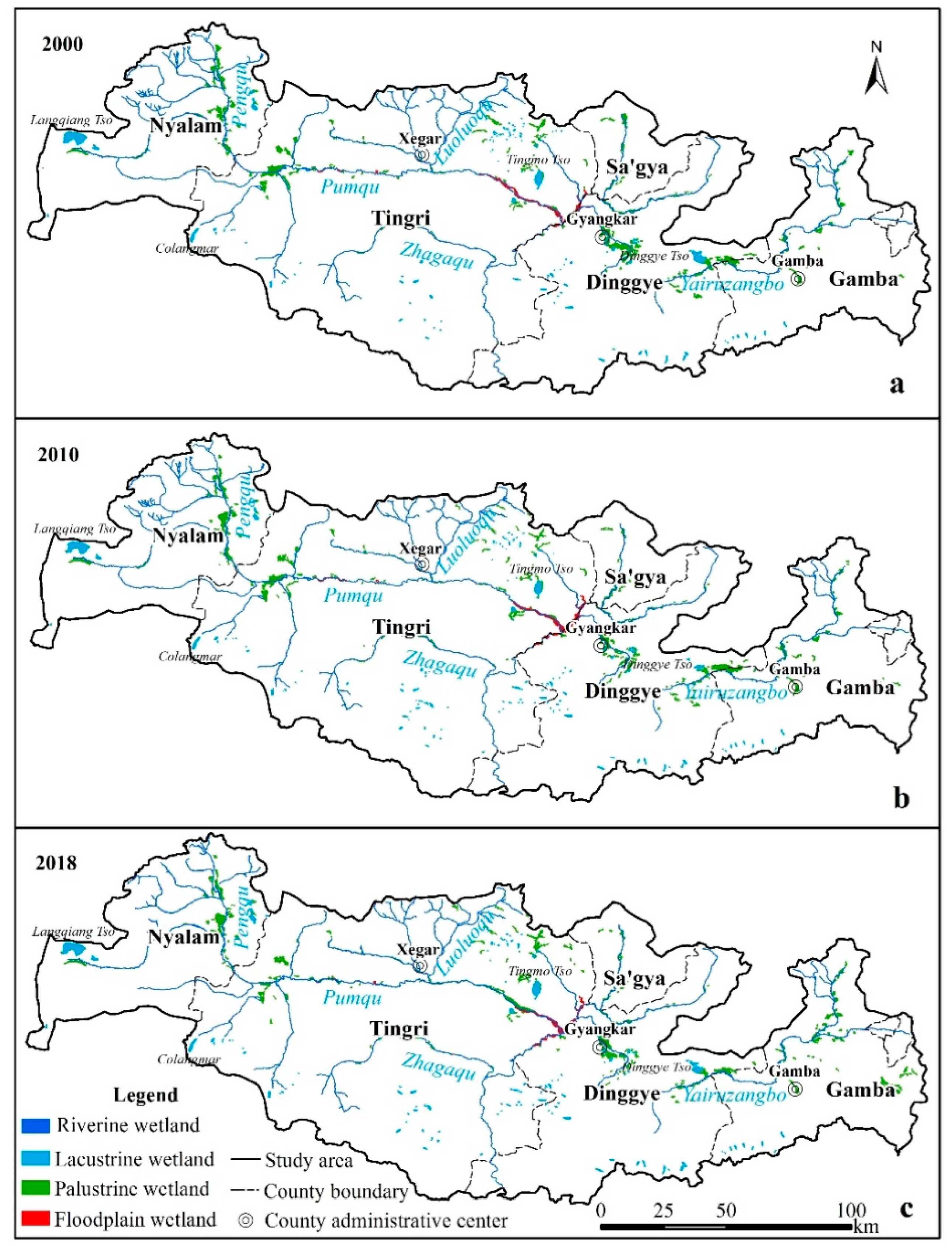
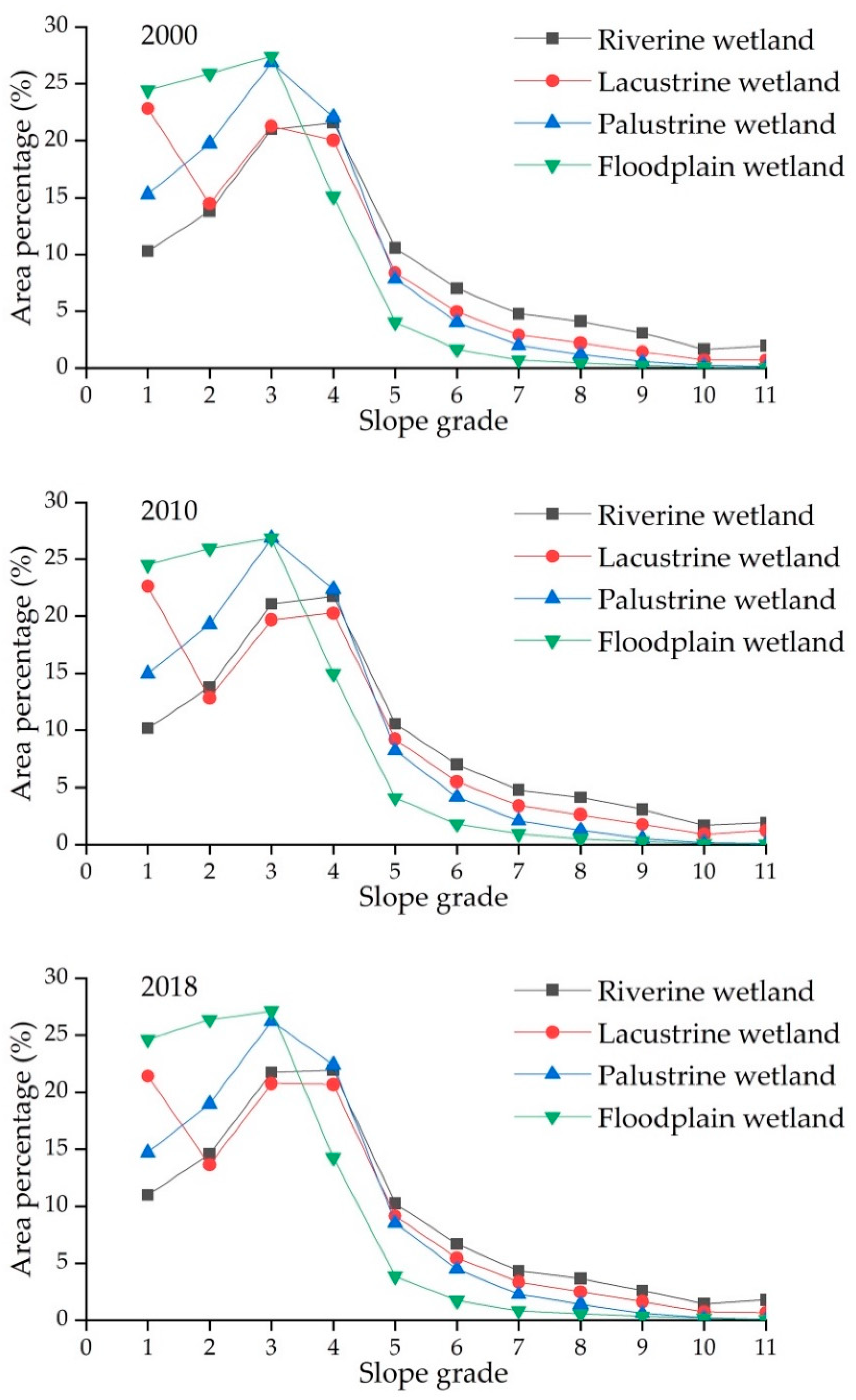
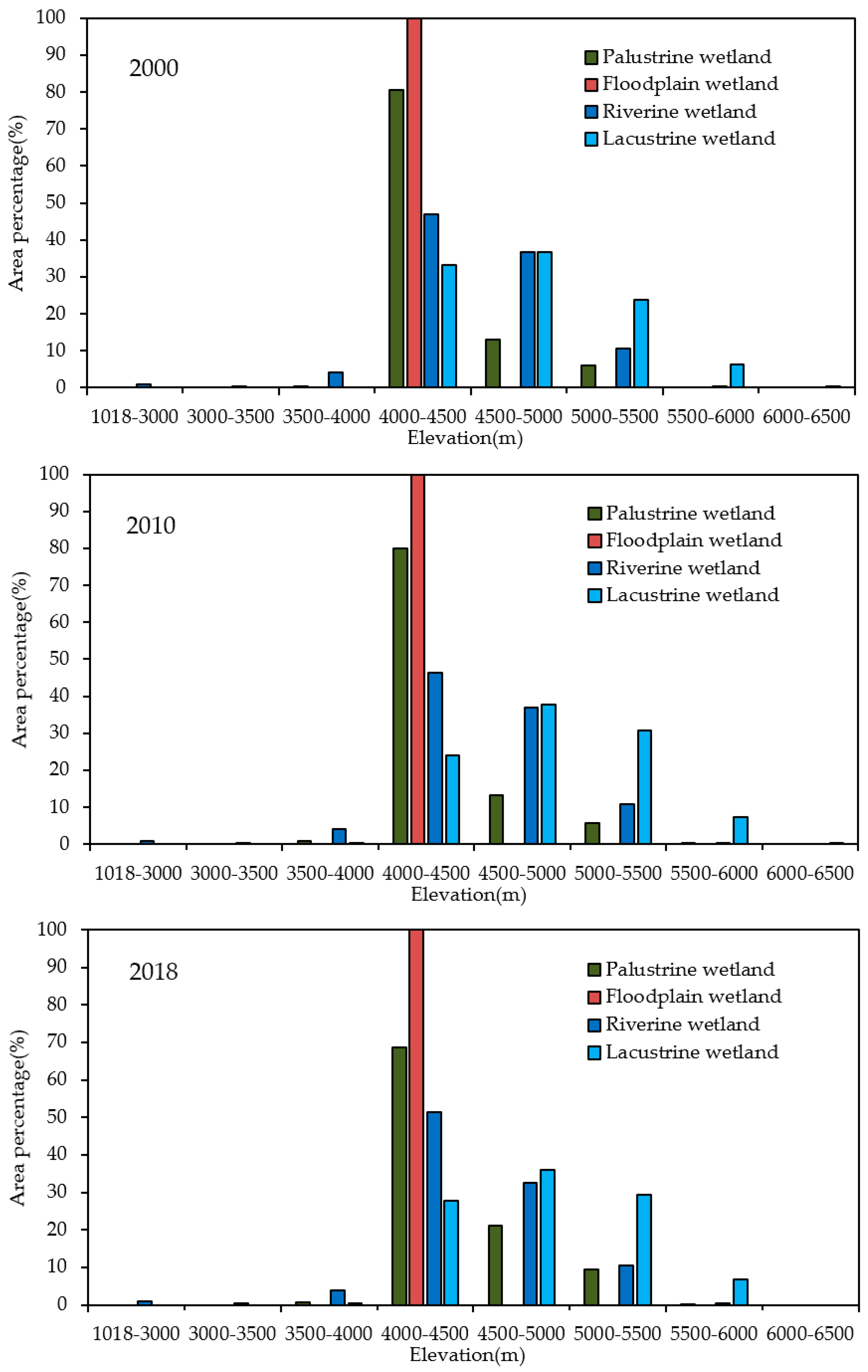
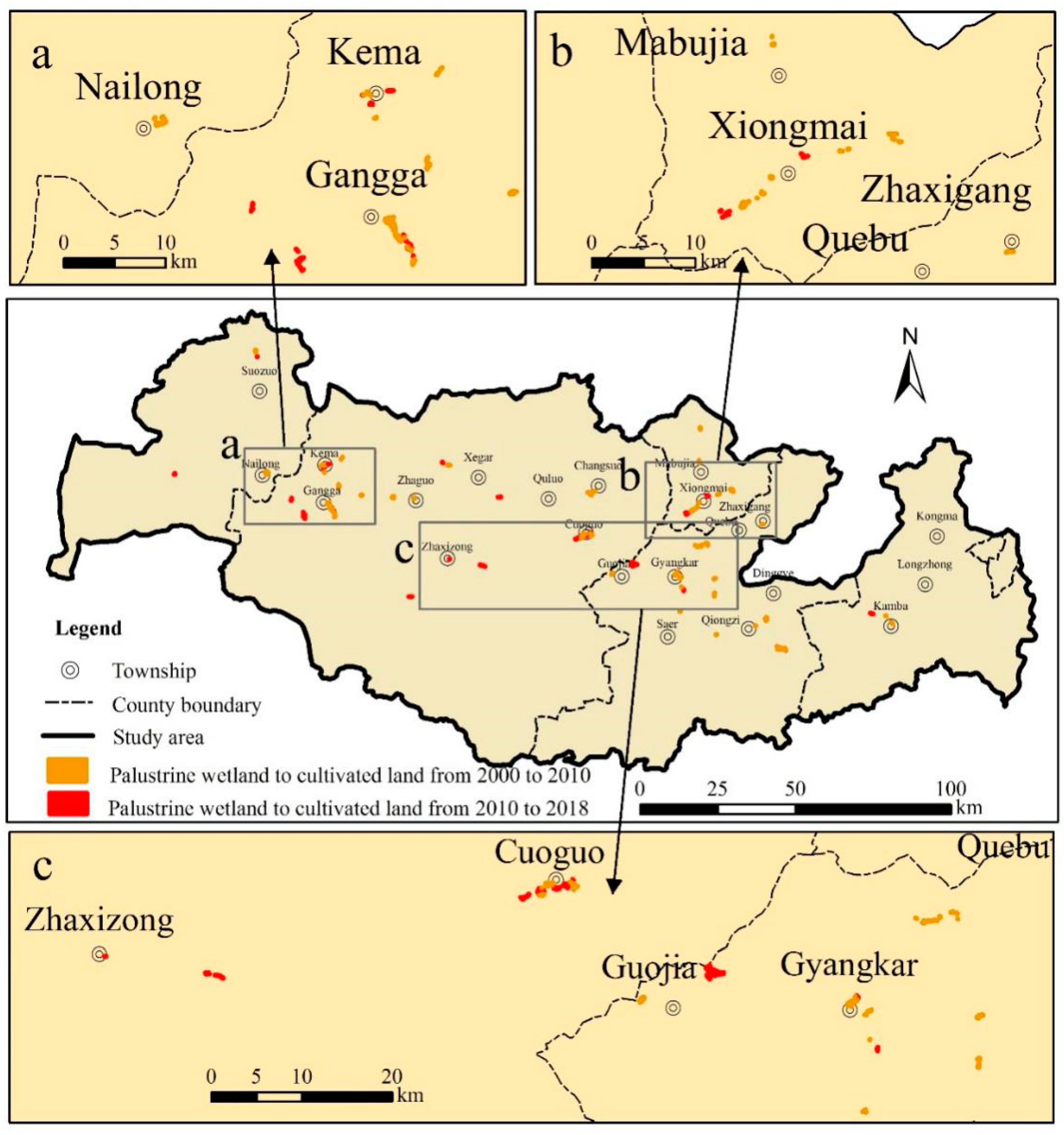
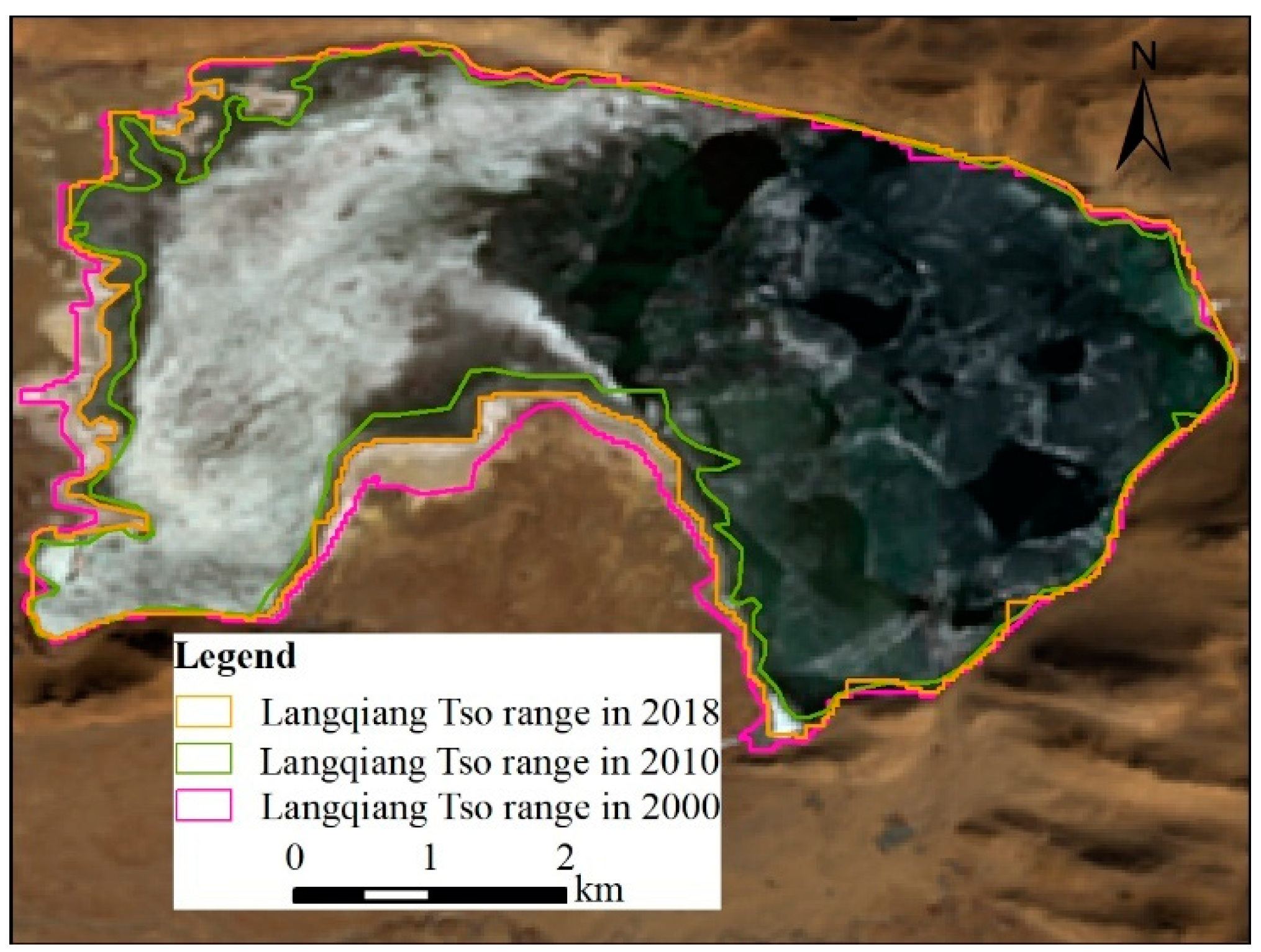
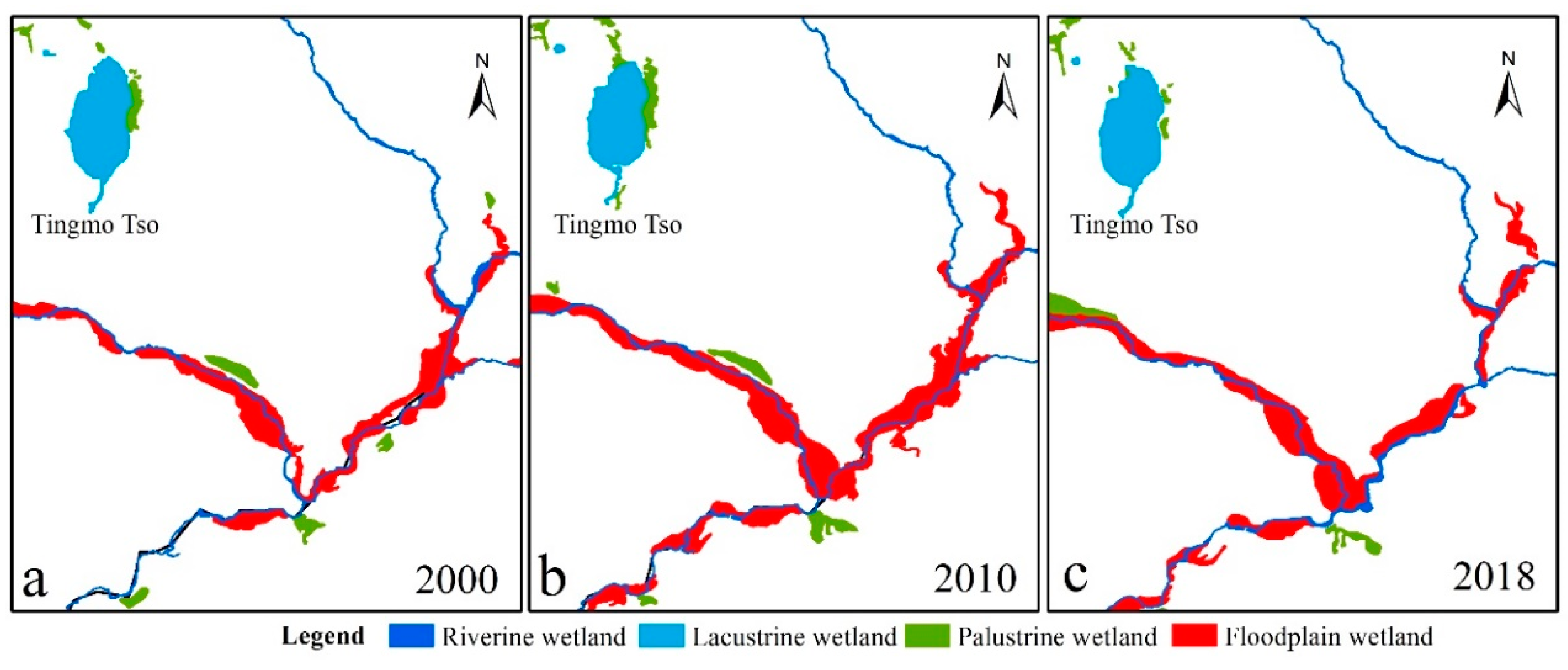
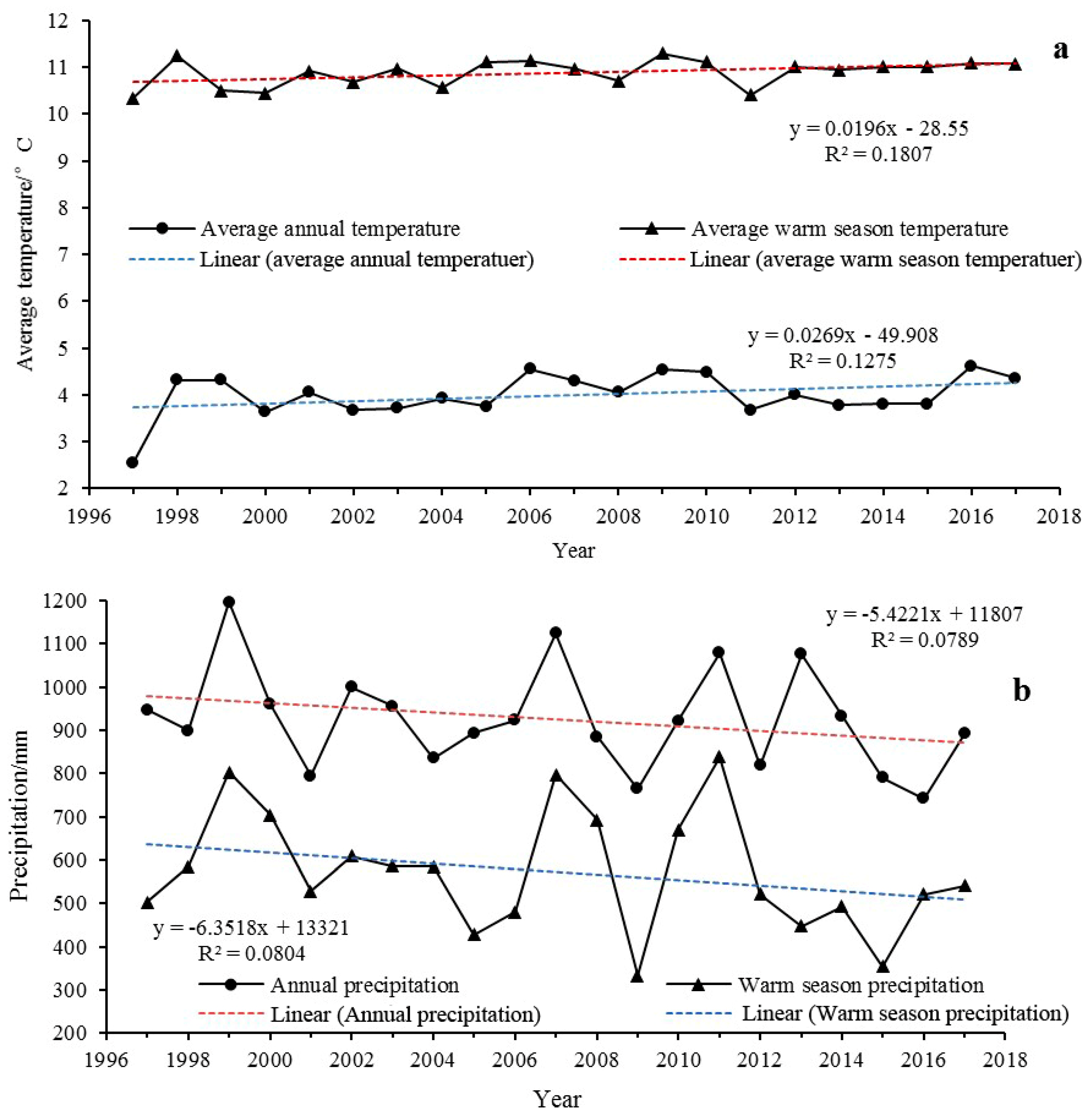
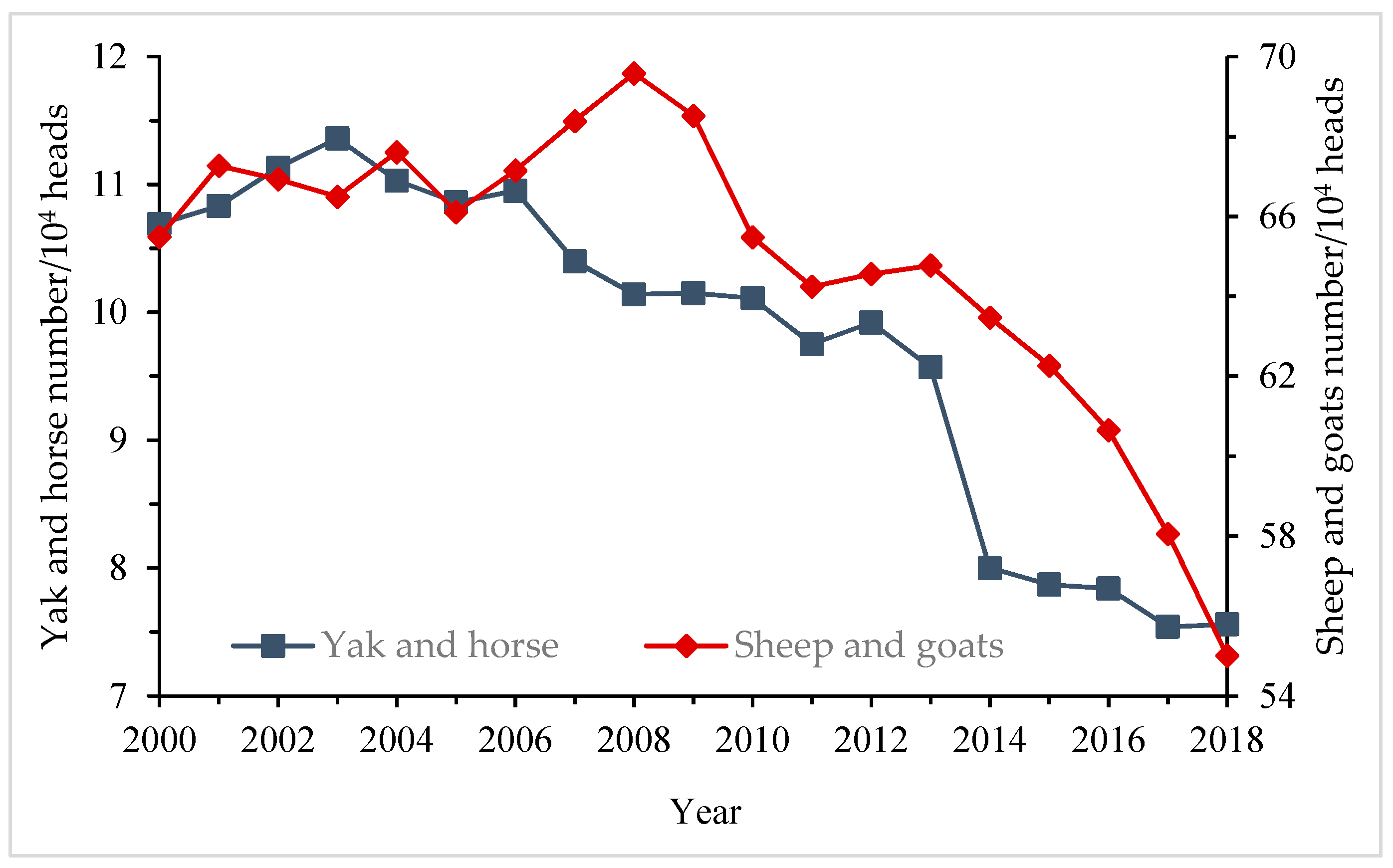
| Path | Row | Acquisition Date | ||
|---|---|---|---|---|
| 139 | 40 | 30 November 1999 | 2 April 2010 | 7 March 2018 |
| 139 | 41 | 17 January 2000 | 13 February 2010 | 7 March 2018 |
| 140 | 40 | 24 January 2000 | 9 April 2010 | 14 March 2018 |
| 140 | 41 | 21 November 1999 | 5 March 2009 | 9 January 2018 |
| 141 | 40 | 3 March 2000 | 9 December 2009 | 16 January 2018 |
| Classification System of Wetland | Characteristics | Interpretation Keys | Image |
|---|---|---|---|
| Riverine wetland | Permanent or intermittent moving water bodies, excluding floodplain and ait. | It appears as black or blue-black and has a long and narrow curve in images. |  |
| Lacustrine wetland | Under the crustal tectonic movement, glaciation, river erosion, the surface forms concave fields, and the water accumulates into the lake. The lacustrine wetland (including the glacial lake) does not include the surrounding wetlands. | It appears as blue or black in images, with an irregular shape, uniform tone but clear boundaries with the land. |  |
| Palustrine wetland | Dominant species are aquatic plants, which are distributed in valleys or low-lying plains, and the wetlands are related to the supply of abundant water such as rivers, glaciers and springs. | It appears as light red and some with light blue or black hydrological marks in images. |  |
| Floodplain wetland | Plain areas on both sides of inundated rivers, including beaches, flooded valleys and flooded grasslands. | It appears as blue-gray, blue-black or brown-red, distributed along the river. |  |
| Type | 2000 | 2010 | 2018 | 2000–2010 | 2010–2018 | 2000–2018 | ||||||
|---|---|---|---|---|---|---|---|---|---|---|---|---|
| km2 | % | km2 | % | km2 | % | km2 | Change% | km2 | Change% | km2 | Change% | |
| Riverine wetland | 131.41 | 0.53 | 128.83 | 0.51 | 132.76 | 0.53 | −2.58 | −1.96 | 3.93 | 3.05 | 1.35 | 1.03 |
| Lacustrine wetland | 87.77 | 0.35 | 78.21 | 0.31 | 92.89 | 0.37 | −9.56 | −10.89 | 14.68 | 18.77 | 5.12 | 5.83 |
| Palustrine wetland | 228.94 | 0.92 | 211.22 | 0.84 | 205.83 | 0.82 | −17.72 | −7.74 | −5.39 | −2.55 | −23.11 | −10.09 |
| Floodplain wetland | 31.81 | 0.13 | 40.05 | 0.16 | 28.23 | 0.11 | 8.24 | 25.90 | −11.82 | −29.51 | −3.58 | −11.25 |
| Total | 479.93 | 1.92 | 458.31 | 1.83 | 459.71 | 1.84 | −21.62 | −4.50 | 1.40 | 0.31 | −20.22 | −4.21 |
| Nyalam | Tingri | Dinggye | Gamba | Sa’gya | |
|---|---|---|---|---|---|
| Riverine wetland | 0.81% | 0.57% | 0.36% | 0.38% | 0.42% |
| Lacustrine wetland | 0.84% | 0.30% | 0.45% | 0.10% | 0.00% |
| Palustrine wetland | 1.01% | 0.58% | 0.99% | 1.19% | 0.74% |
| Floodplain wetland | 0.00% | 0.19% | 0.12% | 0.00% | 0.00% |
| Grades | 1 | 2 | 3 | 4 | 5 | 6 | 7 | 8 | 9 | 10 | 11 |
|---|---|---|---|---|---|---|---|---|---|---|---|
| Slope (°) | 0–3 | 3–5 | 5–8 | 8–12 | 12–15 | 15–18 | 18–21 | 21–25 | 25–30 | 30–35 | >35 |
| Climatic Factors | Riverine Wetland | Lacustrine Wetland | Palustrine Wetland | Floodplain Wetland | Total |
|---|---|---|---|---|---|
| Annual average temperature | 0.6153 | 0.7610 | 0.5937 | 0.5546 | 0.6586 |
| Warm-season average temperature | 0.8661 | 0.8524 | 0.8017 | 0.5844 | 0.9185 |
| Annual precipitation | 0.5528 | 0.6494 | 0.8324 | 0.5710 | 0.7253 |
| Warm-season precipitation | 0.4454 | 0.5821 | 0.6675 | 0.6519 | 0.5749 |
Publisher’s Note: MDPI stays neutral with regard to jurisdictional claims in published maps and institutional affiliations. |
© 2021 by the authors. Licensee MDPI, Basel, Switzerland. This article is an open access article distributed under the terms and conditions of the Creative Commons Attribution (CC BY) license (http://creativecommons.org/licenses/by/4.0/).
Share and Cite
Zhang, Y.; Yan, J.; Cheng, X.; He, X. Wetland Changes and Their Relation to Climate Change in the Pumqu Basin, Tibetan Plateau. Int. J. Environ. Res. Public Health 2021, 18, 2682. https://doi.org/10.3390/ijerph18052682
Zhang Y, Yan J, Cheng X, He X. Wetland Changes and Their Relation to Climate Change in the Pumqu Basin, Tibetan Plateau. International Journal of Environmental Research and Public Health. 2021; 18(5):2682. https://doi.org/10.3390/ijerph18052682
Chicago/Turabian StyleZhang, Yihao, Jianzhong Yan, Xian Cheng, and Xinjun He. 2021. "Wetland Changes and Their Relation to Climate Change in the Pumqu Basin, Tibetan Plateau" International Journal of Environmental Research and Public Health 18, no. 5: 2682. https://doi.org/10.3390/ijerph18052682
APA StyleZhang, Y., Yan, J., Cheng, X., & He, X. (2021). Wetland Changes and Their Relation to Climate Change in the Pumqu Basin, Tibetan Plateau. International Journal of Environmental Research and Public Health, 18(5), 2682. https://doi.org/10.3390/ijerph18052682





